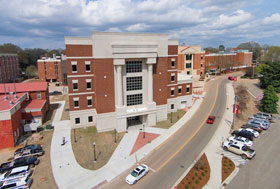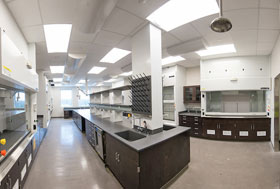TCRC West Wing dedicated

Outgoing UM Chancellor Dan Jones welcomes guests at the dedication ceremony.
ust steps from Vaught-Hemingway Stadium stands one of the most advanced research buildings in the region: the Thad Cochran Research Center West Wing.
Dedicated on April 15 by the University of Mississippi School of Pharmacy and its Research Institute of Pharmaceutical Sciences, the new and innovative facility contains capabilities that could drastically improve the health of Mississippians and people around the world.
Outgoing UM Chancellor Dan Jones welcomed more than 200 guests who joined the School of Pharmacy to commemorate the occasion.
“The opening of the Thad Cochran Research Center West Wing is a great success for the University of Mississippi,” Jones said. “The facility offers endless opportunities for the advancement of natural products research. Studies conducted in this building will have a local, statewide and global impact on health.”
Funded by several federal grants, the West Wing completes the two-building National Center for Natural Products Research complex. The NCNPR is the nation’s only university-affiliated research center devoted to improving human health and agricultural productivity through the discovery, development and commercialization of pharmaceuticals and agrochemicals derived from natural products.
The new wing, or TCRC West, will allow NCNPR scientists to advance their natural products drug discoveries toward commercialization.

The recently completed facility, part of the two-building NCNPR complex, is one of the most advanced in the region.
“This year marks the 20th anniversary of the opening of the NCNPR, so it is very fitting that we can mark the dedication of this new wing in 2015,” said Larry Walker, NCNPR director. “It is exciting to see the achievement of this milestone for Ole Miss and the School of Pharmacy. This completes our world-class natural products research center, as envisioned by the school’s leaders over the years.”
Other notable speakers at the dedication were William Canty, field representative for Sen. Thad Cochran; Steven Musser, deputy director of scientific operations for the U.S. Food and Drug Administration; Alice Clark, UM vice chancellor for research and sponsored programs; David D. Allen, dean of the School of Pharmacy; and Walker.
Decades of preparation
First envisioned in the early 1990s, the NCNPR’s two buildings were planned in two phases. Construction of a portion of Phase I, now TCRC East, began in 1992 with funds from the U.S. Department of Agriculture. Personnel occupied TCRC East in 1995, the building was completed in 2000, and the Centennial Auditorium was added in 2008.
TCRC East was designed for research involving natural products discovery. A science library and repository for botanical specimens accompany TCRC East’s sophisticated laboratories.
Grants from the Health Resources and Services Administration and the FDA initiated construction of TCRC West. Barbara Wells, UM School of Pharmacy dean emeritus, and Charles Hufford, associate dean emeritus, secured the funding with assistance from Cochran and his staff.
In addition to HRSA and FDA support, the university offered funding for the expansion. Furthermore, the American Recovery and Reinvestment Act of 2009 provided an opportunity to complete TCRC West in a single construction project. Walker and Hufford secured a grant from the National Institutes of Health via this program. This ARRA grant was the only one awarded to a pharmacy school nationally.
“The initial funding from HRSA and FDA allowed us to plan Phase II in detail,” Hufford said. “This preliminary planning helped immensely and was a big reason why we were funded by the NIH grant – it was a well-thought-out project that was shovel ready.”
Construction began in 2012. Designed and engineered by Jackson-based firm Cooke, Douglass, Farr and Lemons, the addition to the Thad Cochran Research Center nearly doubles the school’s total research space.

The building nearly doubles the School of Pharmacy’s research space.
Advanced capabilities
The building houses a clinical studies facility, large instrument facility, Biosafety Level 3 laboratory, laboratories for scale-up synthesis and laboratories for expanding efforts to discover natural products.
Unique to the university’s Oxford campus, the clinical area will facilitate FDA-approved clinical evaluations that require testing in humans. An upcoming project involves evaluating two forms of primaquine, an existing drug to treat malaria, for toxicity and efficacy.
“This is likely to be the first study that we conduct in the new facility,” said Don Stanford, RIPS assistant director. “We have studied primaquine for years and have become experts in the drug’s metabolism.”
The large instrument facility houses several nuclear magnetic resonance spectrometers and will soon house a mass spectrometer. The school recently overhauled its NMR suite. A number of these new machines will be housed in the facility with the potential to house all eight of the school’s NMRs.
The Biosafety Level 3, or BSL-3, lab will allow the university to do research using biological agents that have previously been prohibited on campus. The space acts as a containment room that allows researchers to have complete atmospheric control.
Several of these capabilities will have campuswide implications, Stanford said. The clinical studies facility, large instrument facility and BSL-3 lab are designated as core centers on campus. Core centers are facilities that can be used by a number of investigators in various university departments.
“For example, the nutrition and hospitality management department has already expressed interest in our clinical studies facility, and a biology professor has received a grant that requires access to a BSL-3 laboratory,” Stanford said. “We are thrilled that researchers throughout the university will benefit from these enhanced capabilities.”
Components of the building itself are highly sophisticated and sustainable. The building features an energy-recovery system that will dramatically decrease operating costs. In addition, all flooring is made from recycled materials. Both of these components, among others, will aid in the facility’s Leadership in Energy and Environmental Design (LEED) certification, a national “green building” certification program.
Unique training laboratory
To advance the study of natural products as dietary supplements, Waters Corp. and the School of Pharmacy have partnered in the creation of a natural products training laboratory in the new building.
The space will serve to educate government officials, academic or industry professionals, and scientists on best practices in natural products and botanical dietary supplements. One-week courses will be offered to interested individuals and taught by NCNPR personnel.
“This training lab was created while keeping the future of the dietary supplement industry in mind,” said Ikhlas A. Khan, NCNPR associate director. “This will be a great resource for people to get hands-on training and develop the skills to implement good manufacturing practices.”
According to the lab’s mission, it will serve to ensure uniform scientific standards in the advancement of commercially viable natural products by “demonstrating leading-edge techniques using world-class analytical and sample preparation supplies and consumables.”
Waters will loan several pieces of cutting-edge analytical and separation equipment to the university for five years as part of establishing the laboratory.
“Waters is committed to partnering with world-class experts to foster new ideas and promote innovation,” said Richard Ladd, Waters Corp. senior director of pharmaceutical business. “We are very pleased to collaborate with the National Center for Natural Products Research at the University of Mississippi in establishing the state-of-the-art Natural Products Training Laboratory. The training laboratory will increase scientific and regulatory knowledge and promote the use of global best practices in dietary and botanical supplement testing.”
Looking ahead
With the completion of TCRC West, research at the School of Pharmacy will continue to grow for years to come. The building will accommodate more than 100 scientists.
Allen said that the new facility will help the school succeed in its greatest mission, which is to positively affect health and well-being.
“The sky is now truly the limit in terms of what we can accomplish through our work with natural products,” Allen said. “This is a great advancement for our school and research institute.”
Clark echoed Allen’s sentiment and emphasized the incredible impact that the facility will have.
“The center’s stellar record of achievement has laid a solid foundation for many decades to come,” Clark said. “The science done here will continue to inform agencies, policymakers, industry, consumers and the broader scientific community. And as an educational institution, this is the epicenter of the next generation of scientists who will explore the chemistry and biology of botanicals that affect human health.”
|

